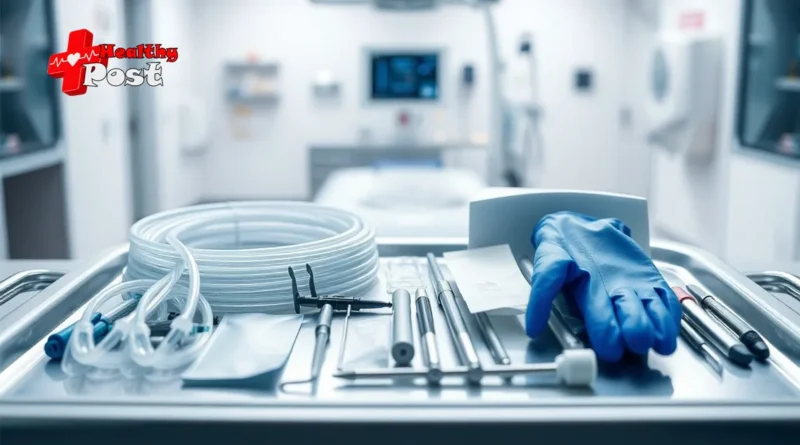Comprehensive Guide to Nasopharyngeal Airway Kit: Essential Equipment for Airway Management
Airway management is a critical part of emergency care and anesthesia. It can mean the difference between life and death in many situations. One tool that has gained popularity is the nasopharyngeal airway kit. This kit helps keep the airway open, especially when other methods aren’t effective. It includes essential parts like the airway tube, lubricants, and sizing tools. Picking the right kit and knowing how to use it properly is key to keeping patients safe and ensuring good ventilation.
Understanding the Nasopharyngeal Airway Kit
What Is a Nasopharyngeal Airway Kit?
A nasopharyngeal airway kit is a set of medical tools designed to help keep a person’s airway clear. Typically, it contains a flexible tube, lubricants, sizing guides, and sterile packaging. These kits are used mainly to prevent airway blockages in patients who are semi-conscious or unconscious. Compared to other devices, like oropharyngeal airways, they can be gentler and more appropriate for certain patients. They also work well if the mouth is injured or blocked.
Components of a Typical Kit
Most kits include multiple sizes of airway tubes. These range from small for children to larger sizes for adults. Lubricant, often water-based, makes insertion easier while reducing discomfort. Some kits come with guides or safety labels to improve correct placement. Because brands vary, some kits may have additional accessories or features. Always check what’s included before use to ensure compatibility with your patient’s needs.
Selecting the Right Kit
Choosing the proper nasopharyngeal airway kit involves considering patient age and size. For example, small children need smaller tubes, while adults require larger ones. The clinical setting, like emergency or hospital use, also influences your choice. Proper sizing is vital to avoid trauma or discomfort. Use standardized sizing charts to help find the right fit, and always measure from the patient’s nostril to the earlobe or mandibular angle.
Proper Use and Insertion Techniques
Preparing for Insertion
Begin with a patient assessment first. Check for nasal obstructions, injuries, or previous nasal surgeries. Prepare the equipment by sterilizing or opening sterile packaging. Position the patient with the head tilted slightly back—this opens the nasal passages. Ensure you have lubricants ready and a clean environment to minimize infection risk.
Step-by-Step Insertion Process
Start by applying a water-based lubricant generously to the airway tube. Gently insert the tube along the natural curve of the nasal passage, never forcing it. Keep the tube tilted downward as you slide it in. Once it reaches the correct depth—usually until you meet resistance or it reaches the nostril’s base—check if the airway is open by feeling for airflow. Adjust positioning if needed.
Safety Tips and Common Mistakes
Watch for signs of improper placement such as resistance, bleeding, or patient distress. Never force the tube, as this risks nasal trauma or bleeding. If you encounter resistance, withdraw slightly and reassess. If bleeding occurs, stop and control the bleeding. Reevaluate the need for alternative airway devices if initial placement fails.
Advantages and Limitations of Nasopharyngeal Airway Kits
Benefits in Emergency and Clinical Settings
Nasopharyngeal airways are easy to insert, even in semi-conscious patients. They quickly maintain airway patency, reducing the risk of airway obstruction. They are especially useful for patients with oral injuries or when oral access is limited. Their flexibility makes them more comfortable for longer use.
Limitations and Precautions
Risks include nasal bleeding, trauma, or sinus injuries. Not suitable for patients with nasal fractures, severe septal deviations, or recent nasal surgery. In cases of suspected skull fractures, insertion can worsen brain injuries or lead to complications. Always evaluate nasal structures before use and consider alternative devices if contraindications exist.
Comparing with Other Airway Devices
Oropharyngeal airways are better suited for unconscious patients unable to maintain their airway. Nasopharyngeal airways work well for semi-conscious or conscious patients. When choosing, consider the patient’s condition, oral injuries, and ability to tolerate different airway adjuncts.
Maintenance, Monitoring, and Removal
Post-Insertion Care
Monitor the airway continuously for displacement, obstruction, or bleeding. Keep the area clean and dry to prevent infection. Regularly check that the tube remains in place and that airflow is maintained. Comfort the patient if they experience discomfort, and document the device’s position.
Removal Procedures
Remove the nasopharyngeal airway when it’s no longer needed or if complications arise. Do this gently to avoid trauma or bleeding. Once removed, assess the patient’s airway and document the event. If airway patency is compromised, prepare for alternative airway management options.
Conclusion
A nasopharyngeal airway kit is a vital tool in airway management across many settings. Proper selection, precise insertion, and careful maintenance are essential for patient safety. Always consider individual patient needs and keep updated on best practices. Regular training and adherence to clinical guidelines ensure these devices serve their purpose well. When used correctly, a nasopharyngeal airway kit can save lives and improve patient outcomes in critical moments.


